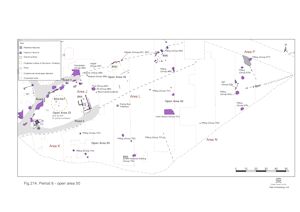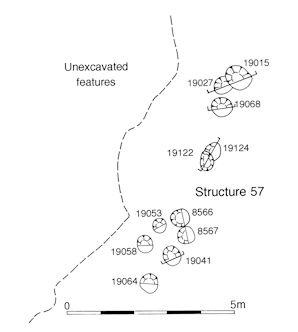
While the continuance of OA28 in Period 5 is uncertain, its survival into Period 6 is very doubtful. While the Southern Zone construct is retained within this narrative, as much for convenience as anything, OA28 is now subsumed into OA50 (Figure 214). With the apparent disuse of Road 3, it is entirely possible that OAs 50 and 45 are now undifferentiated - perhaps even extending to the incorporation of OA23. However, for the sake of simplicity of presentation, OA50 is retained here.

The majority of evidence for Period 6 land-use across the southern part of the lower terrace is in the form of generally scattered pits. While these contain latest Roman rubbish deposits, very small quantities of Early Saxon pottery in a few suggest that deposition continues into the 5th century. As such, it is very difficult to separate out the latest Roman and Early Saxon features and it is unlikely to be particularly instructive to do so. Virtually all of these pits contain significant quantities of residual material, so their apparent richness in finds should not necessarily be interpreted as a straightforward resurgence in prosperity at the end of the 4th century AD; the overall picture of there being little activity in this vicinity is probably more accurate. Nevertheless, these latest pits contain significantly more finds than those of Period 5.
The only definitive Early Saxon structure identified to occupy OA50, Building 65, is described separately.
Despite the presence of occupation features extending into, and perhaps beyond, the late 4th century elsewhere within the settlement, contemporary pitting is sparse across OA50, given its large area. Pit occurrence is described from west to east.
Although scattered, the latest Roman pits (4128, 4139, 4153, 4224, 4714 Group 744) at the western end of OA50 (Excavation Area K) are surprisingly homogeneous in form - all being between 1.6m and 2m wide and basically circular. All contain large and varied artefact assemblages in comparison with those of OA28 of earlier periods. Of note is the large and varied assortment of metal objects. Many appear to be small personal possessions such as a strigil (SF426), stylus (SF1150), knife (SF1936) and tweezers (SF1073), which occur along with bone hairpins (SFs 416, 428), beads (SF6840) and shale bracelet fragments (SF1840). Following previous trends, bulk materials, such as tile, bone and, to a lesser extent, oyster shell are also increasingly common.
In the central part of OA50, pits 15421, 15423, 15966, 24456 (Group 701) perhaps form a southward continuation of the pits within OA60 (Excavation Area M, Groups 471, 988). Of these, pit 15423 contains Early Saxon pottery. This may indicate either that such pits continue to be filled this late, or that slump hollows develop in their tops within which Early Saxon material accumulates. The slump hollow (24456) that develops over late 1st-century AD pit 15773 (Group 691) certainly contains Saxon pottery. Similarly, Period 5 pit 20193 (Group 718) accumulates late 4th-century+ material in its top.
Isolated small oval pit 11507 (Group 700) is located toward the eastern end of OA50 (Excavation Area N) and contains two sherds of Early Saxon pottery.
A number of Late Roman pits are also dug at the easternmost investigated part (Excavation Area P) of OA50 (8793 Group 677, 8513, 8633, 8635, 8637, 8801, 19047, 19172 Group 678, 8736/8788 Group 902). These are widely spaced and slightly irregular in shape, but typically c. 3m diameter and generally in excess of 0.5m (to over 0.8m) deep. Pit 8736/8788 is the only one of these to contain identifiably Early Saxon pottery. The remainder of the pits contain fairly prolific late 4th-century assemblages, generally comprising in excess of 10kg of tile and a variety of other finds including pottery, animal bone, glass, small copper-alloy items (pin, ring, stud, etc.) and unworked stone rubble. Unlike the Period 5 pits in this part of the settlement, ironwork, principally nails, is present, along with small amounts of slag, lead artefacts and waste. Strangely, briquetage (normally an inclusion in Late Iron Age/earliest Roman features) makes a reappearance in these late pits, though is surely residual.

A distinct linear cluster of post-holes (8566, 8567, 19015, 19027, 19041, 19053, 19058, 19064, 19068, 19122, 19124 Group 679), some of which contain a sherd or two of Saxon pottery, is located among the pits in Excavation Area P (Figure 219). The post-holes are all similarly sized, but form no definite structural pattern. It is likely that further examples remain unexcavated to the west, perhaps forming a fenceline.
Internet Archaeology is an open access journal based in the Department of Archaeology, University of York. Except where otherwise noted, content from this work may be used under the terms of the Creative Commons Attribution 3.0 (CC BY) Unported licence, which permits unrestricted use, distribution, and reproduction in any medium, provided that attribution to the author(s), the title of the work, the Internet Archaeology journal and the relevant URL/DOI are given.
Terms and Conditions | Legal Statements | Privacy Policy | Cookies Policy | Citing Internet Archaeology
Internet Archaeology content is preserved for the long term with the Archaeology Data Service. Help sustain and support open access publication by donating to our Open Access Archaeology Fund.